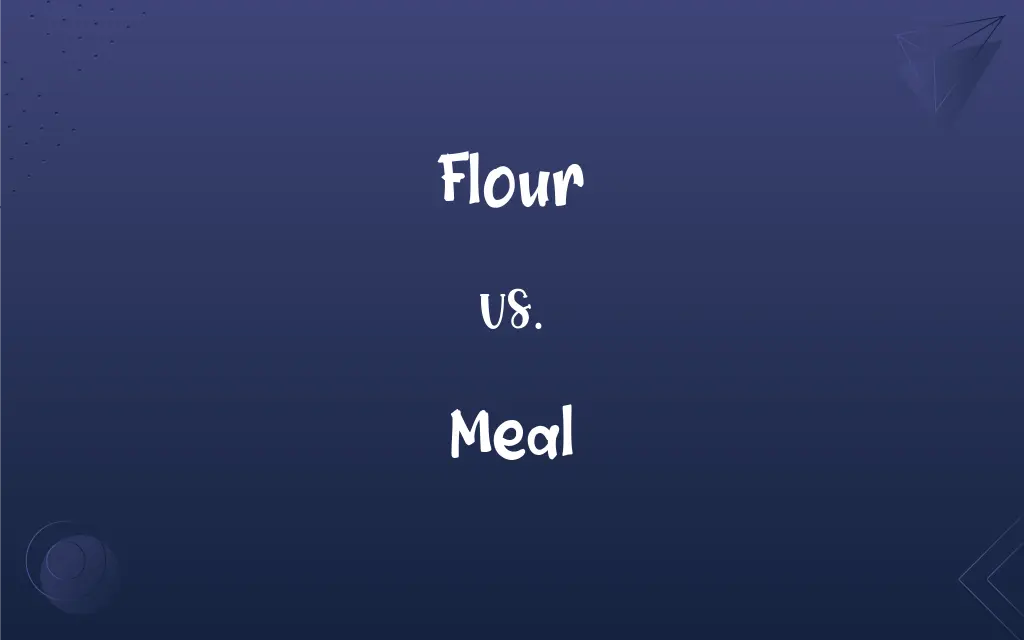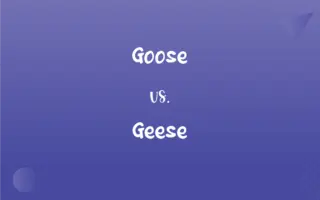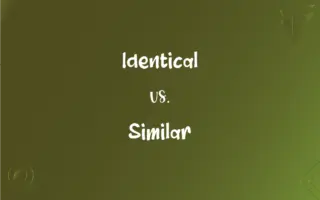Flour vs. Meal: What's the Difference?
Edited by Harlon Moss || By Janet White || Updated on September 26, 2023
Flour is a fine powder made by grinding grains or other foods, whereas meal is coarser in texture and can refer to any ground grain or the occasion on which food is eaten.

Key Differences
Flour and meal both refer to the ground state of grains or edible seeds, but they differ primarily in their texture and uses. Flour is characterized by its fine, powdery consistency, typically obtained through a finer grinding process. In contrast, meal tends to have a coarser texture, retaining some of the graininess of the original substance, indicating a less refined grinding process.
Flour is a staple ingredient in baking and cooking, used as a base for creating a variety of dishes like bread, cakes, and pastries, owing to its smooth texture that allows for versatile applications. Meal, however, is often utilized as a hearty, nutritious component in dishes, such as in cornmeal for making polenta or grits, due to its coarser texture providing a distinctive taste and feel.
When exploring the concept of flour, it is crucial to consider its ubiquity in culinary practices, acting as a binding and leavening agent, contributing to the structure and texture of food items. Conversely, meal, with its more pronounced texture and robustness, can bring a rustic quality to dishes, adding a distinct character and flavor profile that is less uniform than that of flour.
The use of flour is widespread, featuring in countless recipes and culinary traditions, serving as an essential component in the creation of numerous food items. Meanwhile, meal, although perhaps less prevalent in some cuisines, holds a significant place in various culinary traditions, offering a unique texture and flavor profile that enriches the diversity of culinary creations.
Flour, with its refined texture, is a universal ingredient, serving as a foundational element in both sweet and savory culinary applications. In contrast, meal, with its hearty and grainy texture, stands as a versatile ingredient that can be used to impart a distinctive texture and taste to a variety of dishes, highlighting the contrasting nature and uses of these two culinary elements.
ADVERTISEMENT
Comparison Chart
Texture
Fine, powdery
Coarser, grainy
Use
Used in baking and cooking as a base
Used as a nutritious component in dishes
Processing
More refined grinding process
Less refined grinding process
Common Types
Wheat flour, rice flour
Cornmeal, almond meal
Culinary Role
Acts as a binding and leavening agent in various dishes
Adds a rustic quality, distinct character, and flavor
ADVERTISEMENT
Flour and Meal Definitions
Flour
Flour serves as a crucial ingredient in baking and is used to create a variety of food items.
Add the flour slowly to avoid clumps in the batter.
Meal
Meal is the coarser, grainy product of grinding grains or seeds.
Cornmeal is essential for making polenta.
Flour
Flour is characterized by its fine, smooth texture, making it suitable for a range of culinary applications.
The fine texture of the flour made it easy to mix with other ingredients.
Meal
Meal adds a distinctive, hearty texture and flavor to dishes.
The almond meal gave a nutty flavor to the cookies.
Flour
Flour is a fine, powdery substance obtained by grinding grains, legumes, or other edible food products.
She used wheat flour to make the bread.
Meal
Meal can refer to any ground grain or even the occasion on which food is eaten.
He prepared a hearty meal for dinner.
Flour
Flour can be made from a variety of sources, including wheat, rice, and almonds.
Rice flour is a gluten-free alternative to wheat flour.
Meal
The edible whole or coarsely ground grains of a cereal grass.
Flour
A fine, powdery foodstuff obtained by grinding and sifting the meal of a grain, especially wheat, used chiefly in baking.
Meal
A granular substance produced by grinding.
Flour
Any of various similar finely ground or powdered foodstuffs, as of cassava, chickpeas, or bananas.
Meal
The food served and eaten in one sitting.
Flour
A soft, fine powder.
Meal
A customary time or occasion of eating food.
Flour
To cover or coat with flour.
Meal
Correct quotes
Flour
To make into flour.
Meal
Move Middle English to an Middle English (enm) entry
Flour
Powder obtained by grinding or milling cereal grains, especially wheat, or other foodstuffs such as soybeans and potatoes, and used to bake bread, cakes, and pastry.
Meal
Possible search real New English citations for obsolete senses}}
Flour
The food made by grinding and bolting cleaned wheat (not durum or red durum) until it meets specified levels of fineness, dryness, and freedom from bran and germ, also containing any of certain enzymes, ascorbic acid, and certain bleaching agents.
Meal
(countable) Food that is prepared and eaten, usually at a specific time, and usually in a comparatively large quantity (as opposed to a snack).
Breakfast is the morning meal, lunch is the noon meal, and dinner, or supper, is the evening meal.
Flour
Powder of other material.
Wood flour, produced by sanding wood
Mustard flour
Meal
(countable) Food served or eaten as a repast.
Flour
Obsolete form of flower
Meal
A break taken by a police officer in order to eat.
Flour
(transitive) To apply flour to something; to cover with flour.
Meal
(obsolete) A time or an occasion.
Flour
(transitive) To reduce to flour.
Meal
The coarse-ground edible part of various grains often used to feed animals; flour or a coarser blend than flour.
Flour
(intransitive) To break up into fine globules of mercury in the amalgamation process.
Meal
A speck or spot.
Flour
The finely ground meal of wheat, or of any other grain; especially, the finer part of meal separated by bolting; hence, the fine and soft powder of any substance; as, flour of emery; flour of mustard.
Meal
A part; a fragment; a portion.
Flour
To grind and bolt; to convert into flour; as, to flour wheat.
Meal
To yield or be plentiful in meal.
Flour
To sprinkle with flour.
Meal
(transitive) To defile or taint.
Flour
Fine powdery foodstuff obtained by grinding and sifting the meal of a cereal grain
Meal
A part; a fragment; a portion.
Flour
Cover with flour;
Flour fish or meat before frying it
Meal
The portion of food taken at a particular time for the satisfaction of appetite; the quantity usually taken at one time with the purpose of satisfying hunger; a repast; the act or time of eating a meal; as, the traveler has not eaten a good meal for a week; there was silence during the meal.
What strange fishHath made his meal on thee?
Flour
Convert grain into flour
Meal
Grain (esp. maize, rye, or oats) that is coarsely ground and unbolted; also, a kind of flour made from beans, pease, etc.; sometimes, any flour, esp. if coarse.
Flour
Flour acts as a binding and leavening agent, contributing to the texture and structure of dishes.
The flour helps in giving the cake its fluffy texture.
Meal
Any substance that is coarsely pulverized like meal, but not granulated.
Meal
To sprinkle with, or as with, meal.
Meal
To pulverize; as, mealed powder.
Meal
The food served and eaten at one time
Meal
Any of the occasions for eating food that occur by custom or habit at more or less fixed times
Meal
Coarsely ground foodstuff; especially seeds of various cereal grasses or pulse
Meal
Meal is less refined than flour and retains more of the original substance’s texture.
The coarseness of the meal added a rustic quality to the dish.
Meal
Meal is versatile and can be a component in various dishes, offering a unique texture and taste.
The inclusion of the meal enriched the dish with its robust texture and flavor.
FAQs
Can meal be used as a base in dishes like flour?
Yes, meal can be used as a base in certain dishes, imparting a distinctive, hearty texture and flavor.
Does flour have a smoother texture than meal?
Yes, flour has a smoother, finer texture compared to the coarser texture of meal.
Is cornmeal a type of meal?
Yes, cornmeal is a type of meal, used in dishes like polenta and grits.
Can meal be made from nuts?
Yes, meal can be made from nuts, such as almond meal.
Can flour be used to make sauces?
Yes, flour is often used as a thickening agent to make sauces.
Is rice flour a gluten-free alternative?
Yes, rice flour is a gluten-free alternative to wheat flour.
What is the role of flour in baking?
Flour serves as a crucial ingredient in baking, contributing to the texture, structure, and binding of baked goods.
How does meal differ in texture from flour?
Meal has a coarser, grainier texture, whereas flour is fine and powdery.
What is flour primarily used for?
Flour is primarily used as a base in baking and cooking due to its fine, powdery texture.
Is flour a binding agent in cooking?
Yes, flour acts as a binding and leavening agent, contributing to the structure and texture of dishes.
What are common types of flour?
Common types of flour include wheat flour and rice flour.
Can you use meal to create a rustic quality in dishes?
Absolutely, meal can add a rustic quality, distinctive character, and flavor to dishes.
Is meal less refined than flour?
Yes, meal is generally less refined and retains more of the original substance’s texture.
Can meal enrich the dish with its robust texture?
Yes, meal can enrich dishes with its robust texture and distinct flavor profile.
Does the fineness of flour make it versatile in cooking?
Yes, the fineness of flour makes it versatile and suitable for a wide range of culinary applications.
About Author
Written by
Janet WhiteJanet White has been an esteemed writer and blogger for Difference Wiki. Holding a Master's degree in Science and Medical Journalism from the prestigious Boston University, she has consistently demonstrated her expertise and passion for her field. When she's not immersed in her work, Janet relishes her time exercising, delving into a good book, and cherishing moments with friends and family.
Edited by
Harlon MossHarlon is a seasoned quality moderator and accomplished content writer for Difference Wiki. An alumnus of the prestigious University of California, he earned his degree in Computer Science. Leveraging his academic background, Harlon brings a meticulous and informed perspective to his work, ensuring content accuracy and excellence.































































